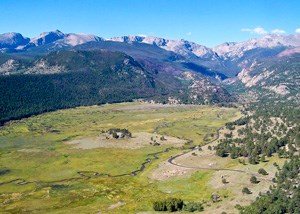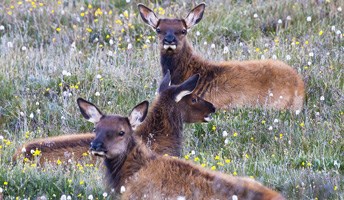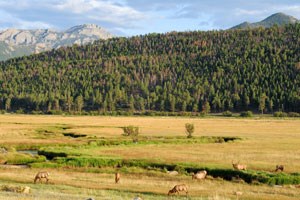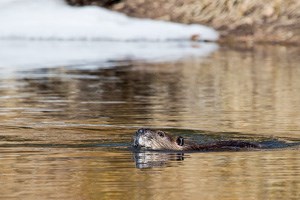
NPS A variety of research studies were conducted before and during the planning process to provide the information needed to develop the Elk and Vegetation Management Plan. The Ecological Role of Elk in Rocky Mountain National Park Research included a National Park Service (NPS) and U.S. Geological Survey research initiative comprised of interdisciplinary studies that assessed the elk population and ecological effects of elk in the park. 
NPS A key part of this research initiative was the development of an ecosystem model to evaluate habitat and species connections over different spatial and time scales. Colorado State University researchers used this model to predict what elk population and winter range conditions would be like under various park management scenarios. Some of these results are mentioned in the sections below. 
NPS Elk Population The park's elk population reached the estimated winter range ecological carrying capacity of approximately 1,000 elk in the early 1990s (Lubow et al. 2002). This is the largest number of elk that current vegetation levels can support on the park's winter range. Ecosystem modeling estimated that without management the park's elk population would continue to fluctuate between 800-1,100 animals (Coughenour 2002). It also suggested that a more natural range of 200 to 800 animals would balance elk and vegetation needs. Elk densities varied from very high (171 to 285 elk per square mile) to low (less than 26 elk per square mile) on the winter range (Singer et al. 2002) with much of the foraging concentrated in a few small areas. Research also found that 10 to 25 percent of the elk population stayed on the winter range in the summer (Larkins 1997), rather than migrating to higher elevations, which can severely hinder vegetation growth. Evidence from various studies indicated that high densities of elk can be as harmful as the total population size in terms of impacting vegetation. 
NPS Aspen Aspen trees in the park provide habitat for a large variety of plant and animal species. Research found that existing aspen clones on the core winter range were declining rapidly as they died of old age (Olmsted 1997). Elk browsing had prevented new aspen suckers, or shoots, from maturing into large trees since 1970, the year that elk management ceased (Baker et al.1997, Olmsted 1997, Suzuki et al. 1999). Elk stripped the bark off living trees, opening sites for pathogen invasions that also led to aspen mortality (Hinds 1985). Research indicated that a complete loss of aspen trees in the core winter range would occur if high elk numbers continued. Ecosystem modeling indicated that aspen stands would be able to regenerate with lower elk densities on the range for shorter periods of time (Weisberg and Coughenour 2003). 
NPS Willow Willow communities also support a wide variety of plants and animals. While human activities have influenced willow communities in the park for over 100 years, research found that elk browsing had significantly reduced the heights and volumes of existing willow shrubs (Peinetti et al. 2001). Another study determined that densities above 32 elk per square mile decreased willow growth and size measurements by 40 percent (Singer 2002). Seed reproduction used to be the primary method for willow establishment on the winter range, but excess herbivory had limited the growth of mature willows that produce seed (Gage and Cooper 2004a, 2004b). Ecosystem modeling predicted that willow recovery could occur if elk browsing pressures decreased (Coughenour 2002). Active willow restoration efforts could also be used to facilitate willow restoration (Gage and Cooper 2004a, 2004b). 
NPS/Jim Westfall Beaver Beaver activity is essential to the physical structure and function of riparian ecosystems (Baker 2005). They were once abundant in Rocky Mountain National Park but declined rapidly after 1940, due largely to a period of trapping (Baker et al. 2003). It was around this time historical records also documented that elk were outcompeting beaver for willow habitat (Packard 1947). At least 10 acres of tall willow is needed to sustain one beaver colony indefinitely (Baket et al. 2003). As the elk population grew, elk consumed willow and the beaver population continued to decrease. Important ecosystem processes that the beaver had provided were lost. Research estimated there had been a 90 percent reduction in the beaver populations of the park's core winter range (Peinetti et al. 2002, Zeigenfuss et al. 2002).
Public Perception Social science research assessed public preference for management actions and desired elk and vegetation conditions in the park (Stewart et al. 2004). The study found that 90 percent of respondents agreed with statements that proposed decreasing elk numbers to restore natural conditions. Accepted management actions included those that improved habitat, such as prescribed burning, beaver restoration, and artificial dams that raise water table levels in wetlands. Respondents indicated the highest level of acceptability was a moderate reduction in elk and some intensive management of aspen and willow to allow for regeneration.
Connect to more information about Elk and Vegetation Management below.
|
Last updated: October 2, 2015
